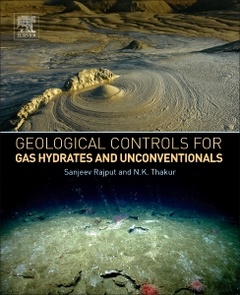Geological Controls for Gas Hydrates and Unconventionals
Auteurs : Rajput Sanjeev, Thakur Naresh Kumar

Geological Controls for Gas Hydrate Formations and Unconventionals tells the story of unconventional hydrocarbon resources, especially gas hydrates, tight gas, shale gas, liquid- rich shale, and shale oil, to future generations. It presents the most current research in unconventionals, covering structural constituents of continental margins and their role in generating hydrocarbons. Additionally, this book answers basic questions regarding quantifications and characterizations, distributions, modes of occurrence, physical and chemical properties, and more ? in essence, all the information that is necessary to improve the models for precision prediction of the enigma of gas hydrates and other unconventionals. Blending geology, geophysics, geomechanics, petrophysics, and reservoir engineering, it explains in simple language the scientific concepts that are necessary to develop geological and reservoir models for unconventionals.Serving as a focal point for geoscientists and engineers conducting research that focuses on reservoir characteristics of unconventionals, Geological Controls for Gas Hydrate Formations and Unconventionals is a useful resource for a variety of other specialiststies including physicists, geochemists, exploration geologists, and petroleum and reservoir engineers. It details the key factors for successful exploration and development of unconventional reservoirs including discovery, data evaluation, full-field development, production, and abandonment, along with a vivid description ofn the worldwide occurrence of unconventional hydrocarbons.
Dr. Naresh Kumar Thakur eceived his Masters in 1970 from Osmania University, Hyderabad, India and Ph.D. from Bombay University, Bombay in 1984. With more than 40 years of research experience in diversified geological and geophysical experimentations, he is presently focusing his research on unconventional hydrocarbon exploration. He has more than 70 peer reviewed papers and two US patents in his credit. He served as a member of United Nations Convention on the Law of the Sea (UNCLOS) and elect representative for five years.
- Includes a range of datasets that provide detailed workflows for geological modeling
- Presents theoretical and real data analysis from different parts of the world, making its content practical and implementable in a range of gas hydrate exploration and extraction scenarios
- Features more than 200 figures and illustrations to highlight key concepts
Date de parution : 05-2016
Ouvrage de 384 p.
19x23.3 cm
Thème de Geological Controls for Gas Hydrates and Unconventionals :
Mots-clés :
acoustic impedance (Z); amplitude versus offset (AVO); and simultaneous inversion; Atlantic margins; AVO attributes intercept and gradient; AVO/AVA modeling; Beaufort Sea; biogenic; biogenic methane; bottom-simulating reflector (BSR); bulk modulus (K); Cape Fear Slide; Cascadian margin; casing shoe; cementation; climatic change; coal; coal bed methane (CBM); coal seam gas; coal seam gas (CSG); conventional and unconventional hydrocarbon reservoirs; demineralization; density (Ï?); deposition; dis


